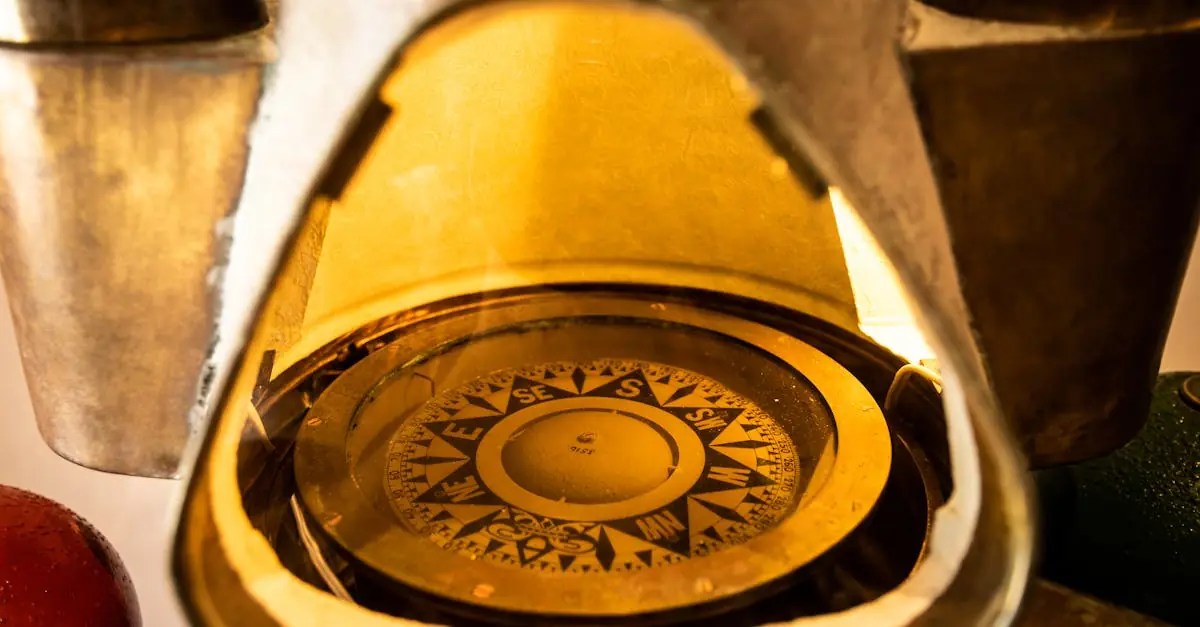Table of Contents
ToggleIn a world where getting lost is just a bad GPS signal away, your iPhone’s compass can be a lifesaver—or a source of frustration. Imagine confidently strutting into the wilderness, only to find your compass pointing you toward a fast-food joint instead of the great outdoors. Fear not! Calibrating your iPhone’s compass is simpler than finding a cat video on the internet.
Understanding Compass Calibration
Calibrating the iPhone’s compass is essential for precision in navigation. It ensures reliability in varied environments.
Importance of Calibration
Calibration plays a vital role in achieving an accurate compass reading. Accurate readings facilitate safe navigation in unfamiliar areas. When the compass isn’t calibrated, users may encounter misleading directions, resulting in potential hazards. Proper calibration helps align the compass with the Earth’s magnetic field. Regular calibration can enhance overall navigation experiences, particularly during outdoor adventures.
Common Issues with Compass Accuracy
Several factors affect compass accuracy on the iPhone. Magnetic interference often causes inaccuracies. This interference can arise from electronic devices, metal objects, or geographical features. Changes in the Earth’s magnetic field may also distort readings. Inconsistent results can frustrate users, especially when precision matters. Additionally, environmental conditions, such as urban surroundings, contribute to errors. Users might find that their compass app requires calibration frequently in areas with high electromagnetic activity. Addressing these issues enhances the reliability of compass functionality.
How to Calibrate Compass on iPhone
Calibrating the compass on an iPhone is essential for accurate navigation. It ensures that users can confidently rely on their device while exploring.
Step-by-Step Calibration Process
- Open the Compass app on the iPhone.
- Follow the on-screen prompts to start the calibration process.
- Move the iPhone in a figure-eight motion.
- Keep moving until the compass registers a calibration success message.
Completing this process helps correct any inaccuracies caused by magnetic interference or environmental factors.
Verifying Calibration
After calibration, verifying the accuracy of the compass is crucial. Open the Compass app and observe the readings.
- Compare the direction with a known landmark or another compass.
- If the compass points correctly, the calibration worked.
- Recalibrate if discrepancies arise.
Regular verification maintains reliable navigation, especially in areas with strong magnetic interference.
Tips for Maintaining Compass Accuracy
Maintaining compass accuracy on an iPhone involves understanding various factors and implementing consistent practices.
Environmental Factors to Consider
Magnetic interference from nearby electronic devices can significantly affect compass readings. Metal objects, such as tools or vehicles, may also disrupt accuracy. Changes in geographical features, like mountains or large buildings, could lead to fluctuations in readings. Additionally, the Earth’s magnetic field varies across different regions, resulting in different levels of accuracy. Awareness of these environmental factors enhances compass reliability. Users should avoid using the compass in close proximity to potential sources of interference for optimal performance.
Regular Calibration Practices
Regular calibration ensures precise compass functionality. Users should recalibrate their compass when transitioning to new locations, especially in unfamiliar areas. Checking the compass’s accuracy against a known reference point helps confirm reliability. Frequent calibration should occur after software updates or significant drops, as these can affect performance. Establishing a routine for calibration during outdoor activities can mitigate errors. Following these practices maximizes navigation efficiency and improves overall outdoor experiences.
Troubleshooting Compass Issues
Calibration issues can arise unexpectedly when using an iPhone compass. Immediate steps can resolve these problems efficiently.
What to Do If Calibration Fails
Ensure the device is free from magnetic interference when calibration fails. Moving away from metal objects or electronic devices often helps. Restarting the Compass app can refresh its functionality. Performing a figure-eight motion again enhances the chances of successful calibration. If problems persist, checking for software updates can also address bugs affecting the compass. Updating iOS often resolves glitches that may disrupt the calibration process. Users should also consider resetting location settings within the settings menu for further troubleshooting.
When to Seek Professional Help
Professional assistance may be necessary if ongoing compass issues emerge. It indicates a potential hardware problem if the compass consistently provides inaccurate readings even after calibration efforts. Contacting Apple Support becomes vital when simple troubleshooting methods fail. Visiting an authorized service center can provide a thorough assessment of the device. Users experiencing erratic compass behavior in multiple applications should consider this option. Frequent navigation errors justify a professional evaluation to ensure safe and accurate device performance.
Calibrating an iPhone’s compass is a simple yet essential task for anyone who values accurate navigation. By following the outlined steps and maintaining a routine calibration practice, users can significantly enhance their outdoor experiences. Regular checks and adjustments ensure that compass readings remain reliable, especially in challenging environments.
Being mindful of potential magnetic interferences and verifying accuracy against known landmarks can further improve navigation confidence. Should calibration issues persist, seeking professional assistance is advisable to maintain the device’s functionality. With these practices in place, users can navigate with ease and assurance.




